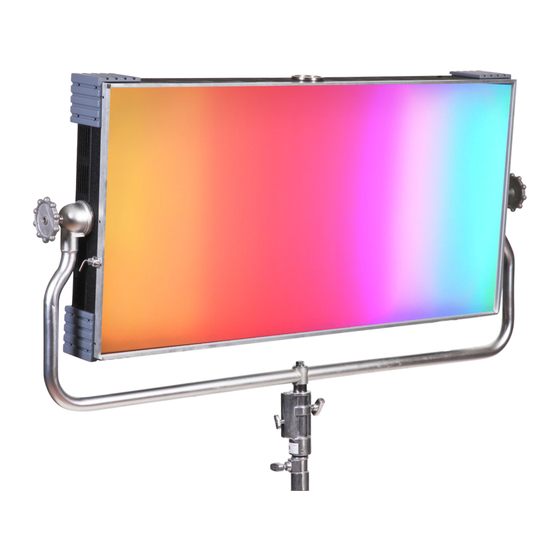
Summary of Contents for Cineo LB800
- Page 1 LB800 User Guide OS Operating System Revision 1.1 March 2021 Information and specifications in this document are subject to change without notice.
- Page 2 OS version. The Lightblade LB800 is built on a multi-zone architecture, i.e. the fixture can be operated as a single, 2’ x 4’ soft source, or it can be operated as 10 individual fixtures in a single chassis, capable of generating dynamic lighting effects.
-
Page 3: General Notes
The LB800 weighs 55 lbs. (25 kg) excluding accessories. The combined weight should be considered when choosing a suitable safety cable. Safety cables must securely be attached to the yoke on LB800 and be as short as possible to reduce travel distance if primary hanging accessory fails. -
Page 4: Component Locations
Component Locations Fixture Front (shown with Portrait Yoke) Diffuser Locking Knobs Accessory Slot Accessory locking latch Junior Pin Fixture Rear (shown with Landscape Yoke) Protective corners support stacking Mounting Points Hinged service doors Connections and controls... - Page 5 Power Connector/Power Switch/Circuit Breaker The LB800 unit is powered by an internal power supply, 110 – 220VAC via a locking PowerCon connector. Power is applied with the switch above the connector. Maximum power draw is 900 watts. A self-resetting circuit breaker is located near the power connection, which requires no user interaction.
- Page 6 The Green icons represent settings, while the teal icons contain additional features and the blue icons are controls. LUTs The first step in setting up the LB800 is defining its overall color space and dim characteristics. The C2OS environment supports variable Look...
- Page 7 2000-10,000K range (eUCS 20-100). The system default is UCS 27-65. When operating the LB800 with other legacy Cineo fixtures, the Cineo 2017 LUT matches the color space of the Standard 410, Lightblades, C80, LB1K and older (non-C2OS) LB800 units. This LUT also selects legacy Cineo PAD dimming curve.
- Page 8 HSIK Controls Wheel Control The Wheel Cursor and Slider controls are the simplest methods for controlling the fixture and are available when the fixture is in 1 or 2-Zone modes. Select the Wheel icon, and a color wheel and four sliders appear: DIM, CCT and HUE and SAT.
- Page 9 Faders Control When the 10-Zone mode is selected, the Faders icon is activated. Selecting this icon displays (10) Zone Sliders, each representing either DIM, CCT, HUE or SAT for each of the 10 zones. By toggling the button in the lower left corner, each of the four attributes for each zone is toggled.
- Page 10 The thermal management of LB800 includes sophisticated software designed to prevent thermal stress. CRMX Wireless In this section, the CRMX radio linking and status are managed. The LB800 includes support for CRMX / Lumen Radio protocol which can receive signals from CRMX and some WDMX transmitters. CRMX receivers always automatically “Link”...
- Page 11 Libraries. The LB800 is shipped with pre-built “Cineo Presets” and “Cineo Effects”, with the ability to create your own. Any Cineo Preset or Effect can be recalled by simply selecting the stored item; it can then be modified and stored as a new item in the “User Presets”...
- Page 12 If creating a new Library, the keypad is displayed for naming the Library, followed by the “New Preset” button. Naming of the Preset follows similar conventions. If storing in an existing Library, “New Preset” button is shown, along with the existing Presets stored in the Library.
- Page 13 Diagnostics. Cineo Customer Service can review the Log files as a troubleshooting tool. Remote Operation The LB800 can be remotely controlled using a wide range of protocols, the simplest of which is DMX/RDM. Current release also supports the built-in CRMX wireless DMX protocol, and future releases will add sACN/ARTNet, Ethernet and Wifi.
- Page 14 DMX Operation Screen When the LB800 is operating from a remote control, the following screen is displayed on the Control screen. This provides substantial information about the current state of the unit, as well as information that may help troubleshoot any communications issues.
-
Page 15: Specifications
Specifications Input Power: 110-240VAC, 800 watts max. via locking PowerCon connector Integrated power supply Fixture Size: 48” W, 24” H, 5.25” D (1.2m W, .6m H, 133mm D Weight: 55 lbs. (25 kg.) Mounting yoke includes Junior Pin Variable saturated color with presets at Red, Yellow, Green, Cyan, Blue, Magenta Variable white/color blending Local and Remote dimming, 0-100% 5-pin wired DMX/RDM In and Thru... - Page 16 If the Product fails to work as warranted, Cineo Lighting will, in its sole discretion, repair or replace the Product with a new or remanufactured Product that is at least equivalent to the original Product. Customer must obtain a Return Material Authorization number from Cineo Lighting before returning any Products under warranty to Cineo Lighting.
- Page 17 In addition, the c2OS can use a different LUT to reproduce Cineo2017 (the original color space used on the c80, Standard410, LightBlades and LB800 products). In the future Cineo will be introducing more LUTs that will be used to map to other color spaces and other fixtures.
- Page 18 The Cineo 2017 uses a Photo-Accurate Dimming curve, which offers light output congruent with lens stops on a camera. Here are examples of how to accurately match camera stops to dimming levels in Local Mode: Local Dimming: The Rule of 20 (0-100 scale)
- Page 19 Appendix B DMX Personalities: LB800 with C PERSONALITY DESCRIPTION SLOT COUNT 1-Zone 8-bit HSIK 1-Zone 16-bit HSIK 1-Zone 8-bit RGBK 1-Zone 16-bit RGBK 8-bit HSIK-G 1-Zone 16-bit HSIK-G 1-Zone 1-Zone 8-bit RGBK-G 1-Zone 16-bit RGBK-G 10-Zone 8-bit HSIK 10-Zone 16-bit HSIK...



Need help?
Do you have a question about the LB800 and is the answer not in the manual?
Questions and answers